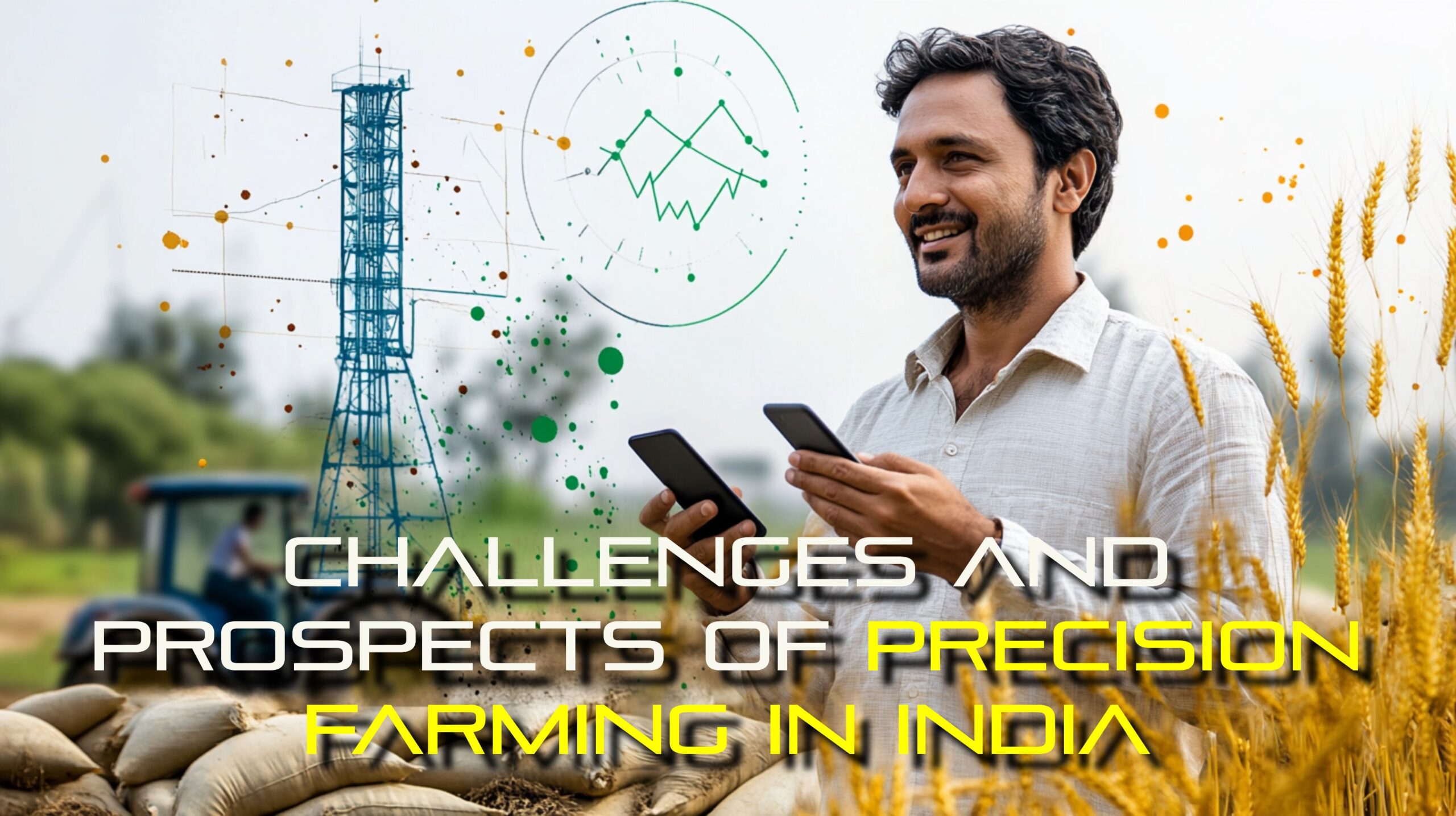Challenges and Prospects of Precision Farming in India
Inspired by Harikishan Sharma’s “E. Explained” article in The Indian Express (September 17, 2024) titled “Centre to Invest Rs 6,000 Crore in Smart Farming with AI, Drones, and Data to Boost Crop Yields,” this essay explores India’s precision farming strategy, proposed by Modi Govt 2.0 in August 2023, aiming to increase crop yields and sustainability using advanced technology. However, challenges like high costs, lack of awareness, and poor infrastructure hinder widespread adoption.
Introduction
Agriculture has always been the backbone of the Indian economy, providing food and livelihood for millions of people. However, traditional farming methods face many challenges, such as unpredictable weather patterns, water shortages, and declining soil quality. As the global population grows, so does the demand for food, putting immense pressure on farmers to produce more while using fewer resources. This is where precision farming comes into play. Precision farming is a new way of farming that uses advanced technologies like drones, sensors, and Artificial Intelligence (AI) to make farming smarter, more efficient, and more sustainable. This method allows farmers to monitor their crops more closely, apply just the right amount of water, fertilisers, and pesticides, and make better decisions based on real-time data. Precision farming holds great promise for increasing crop yields, reducing waste, and protecting the environment. In this essay, we will explore how precision farming is transforming Indian agriculture, the challenges it faces in widespread implementation, and how it can position India as a significant player in the global food supply chain.
Basics of Precision Farming
Precision farming is a modern method of agriculture that uses technology to monitor and manage farm operations with greater accuracy. In traditional farming, farmers often apply water, fertilisers, and pesticides uniformly across their fields, regardless of the specific needs of each plant. Precision farming, on the other hand, uses tools like soil sensors, drones, and AI to determine the exact needs of the crops and apply resources accordingly. For example, soil sensors can measure the moisture level in the soil. If the soil is too dry, the sensor sends a signal to a computer, which then activates the irrigation system to water the plants. This process, known as precision irrigation, ensures that crops receive just the right amount of water, reducing wastage and improving crop health.
Drones are also commonly used in precision farming. These flying machines take pictures of the fields and use special cameras to detect problems like plant diseases, pest infestations, or nutrient deficiencies. With this information, farmers can treat only the affected areas, rather than spraying the entire field with chemicals. This not only saves money but also reduces the environmental impact of farming.
Artificial Intelligence (AI) plays a crucial role in precision farming by analysing data collected from sensors and drones. AI can predict things like when pests are most likely to attack or how much water the crops will need based on weather forecasts. With AI’s help, farmers can make more informed decisions and take timely action to protect their crops.
Benefits of Precision Farming in India
India, with its vast agricultural landscape, stands to gain significantly from adopting precision farming technologies. Here are some of the key benefits:
-
Increased Crop Yields
Precision farming helps farmers grow more food by ensuring that crops receive the right amount of water, fertilisers, and pesticides at the right time. This not only improves plant health but also leads to higher crop yields. For a country like India, where feeding a large and growing population is a priority, precision farming can play a vital role in meeting food security goals.
-
Resource Efficiency
One of the most significant advantages of precision farming is its ability to optimise resource use. India faces severe water shortages in many regions, and traditional irrigation methods often lead to water wastage. With precision irrigation, farmers can significantly reduce water usage by providing crops with just the right amount of water. Similarly, precision farming techniques help minimise the use of fertilisers and pesticides, reducing the cost for farmers and the environmental impact.
-
Environmental Sustainability
Precision farming contributes to sustainable agriculture by reducing the overuse of chemicals and conserving natural resources. The precise application of fertilisers and pesticides prevents the pollution of soil and water sources. Moreover, by improving soil health and minimising soil erosion, precision farming ensures that land remains fertile and productive for future generations.
-
Economic Benefits for Farmers
Precision farming allows farmers to save money by reducing the amount of water, fertilisers, and pesticides they need to use. The increased efficiency leads to lower production costs and higher profits. Moreover, higher crop yields mean that farmers can sell more produce, further boosting their income.
-
Adaptation to Climate Change
India is particularly vulnerable to the effects of climate change, including unpredictable weather patterns, droughts, and floods. Precision farming helps farmers adapt to these challenges by using data to make smarter decisions. For example, sensors and AI can help farmers predict when a drought is likely to occur, allowing them to adjust their irrigation schedules accordingly.
Government Initiatives to Promote Precision Farming
The Indian government recognises the potential of precision farming to revolutionise agriculture and has taken steps to promote its adoption. One such initiative is the establishment of Precision Farming Development Centres (PFDCs) across the country. There are currently 22 PFDCs located in various states, such as Tamil Nadu, Karnataka, Uttar Pradesh, and Bihar. These centres test new farming technologies and provide farmers with hands-on training to help them adopt precision farming practices.
In addition, the government is planning to invest Rs 6,000 crore in smart farming initiatives. This funding will help farmers purchase modern equipment, such as drones and sensors, and will provide financial support through loans and subsidies. The government is also collaborating with countries like Israel and the Netherlands, which are known for their expertise in agricultural technology, to bring the latest innovations to India. The goal is to set up 100 Centres of Excellence (CoEs) over the next five years, where farmers can learn new techniques and see modern farming tools in action.
Challenges of Implementing Precision Farming in India
While precision farming holds great promise for India, several challenges must be addressed before it can be widely adopted.
-
High Costs
One of the biggest obstacles to the widespread adoption of precision farming is the high cost of equipment. Drones, sensors, and AI systems can be expensive, and many small and marginal farmers cannot afford them. Even though the government provides financial support through loans and subsidies, the initial investment can still be a barrier for many farmers.
-
Lack of Awareness and Training
Many farmers, particularly in rural areas, are not familiar with modern farming technologies. The lack of awareness and knowledge about how to use these tools effectively is a significant challenge. While the PFDCs and Centres of Excellence provide training, there is still a need for broader outreach and education programs to ensure that all farmers can benefit from precision farming.
-
Poor Infrastructure
Precision farming relies on internet connectivity to function effectively. Many rural areas in India lack the necessary infrastructure, such as reliable internet access and electricity, to support the use of advanced technologies like sensors and drones. Without proper infrastructure, it is difficult for farmers to take full advantage of precision farming.
-
Fragmented Land Holdings
In India, many farmers own small, fragmented pieces of land. Precision farming tools are often designed for larger farms, where economies of scale make them more cost-effective. For small farmers, using precision farming technology on small plots may not be as financially viable. Addressing this issue may require the formation of farmer cooperatives or Farmer Producer Organisations (FPOs) to pool resources and share equipment.
-
Resistance to Change
Many farmers are accustomed to traditional farming methods and may be reluctant to adopt new technologies. There is often a perception that modern equipment is too complicated or unnecessary. Overcoming this resistance will require ongoing education and demonstration of the tangible benefits of precision farming.
Prospects of Precision Farming in India
Despite these challenges, the future of precision farming in India looks promising. With the right support, India has the potential to become a global leader in smart agriculture. By adopting precision farming techniques, Indian farmers can produce more food using fewer resources, making the country more competitive in the global food market.
India is already one of the largest producers of rice, wheat, and other staple crops. By improving the efficiency of its agricultural sector, India can increase its exports and play a more significant role in the global food supply chain. Precision farming can help Indian farmers meet international standards for food quality and sustainability, making Indian agricultural products more attractive to global markets.
As the global population continues to grow, the demand for food will increase. Precision farming offers a solution to this challenge by enabling farmers to grow more food on the same amount of land. This will not only help India meet its own food security needs but also contribute to global food security.
The rise of precision farming in India has the potential to attract investment in agricultural technology (Agri-Tech). As more companies and startups develop innovative solutions for the farming sector, India could become a hub for agricultural innovation. This will create jobs, boost the economy, and further strengthen India’s position in the global food market.
Conclusion
In India, agriculture is on the verge of being revolutionized by precision farming. This will make farming more intelligent, more efficient, and more environmentally friendly. Drones, sensors, artificial intelligence, and other technology allow farmers to increase their food production while simultaneously reducing the amount of resources they consume. However, there are considerable obstacles, such as substantial expenditures, a lack of awareness, and inadequate infrastructure.



